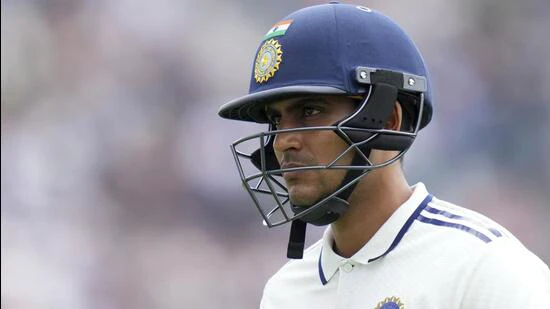Kolkata: To the montage of Shubman Gill bossing the England bowling, exulting after reaching hundreds and that double hundred at Edgbaston, add this disorienting dismissal where he shoulders arms to a ball.
Under overcast Manchester skies, against a bowler who seams the ball more than other England bowlers, it was as shocking a shot selection as it could get. Yet Gill pulled rank to burn a review hoping against hope that the ball might have struck him outside the line.
Gill was probably in denial. He was rushed by pace, understandable because he had mostly faced Liam Dawson’s left-arm slow bowling till before that. But he should have seen it coming because Ben Stokes has a knack for exploring the angles, at a fair pace as well. The ball nipped back in too, which raises the question what made Gill feel his off-stump was secure. Stokes knew it the moment the ball hit the knee roll of Gill’s front pad even though umpire Rod Tucker took his time to agree.
This is the third time Gill has been out to a seamer while not offering a shot in Test cricket. And he now has scored 34 runs in three innings since Edgbaston. It’s the kind of slump you dread after the kind of highs Gill had scaled in the matter of two Tests. Steering this new team through a much-anticipated transition isn’t just Gill’s responsibility. Yashasvi Jaiswal has been in good touch, KL Rahul is a steadying influence, and Rishabh Pant has shown he can change the course of a game. But in the context of Indian cricket, Gill is the next pin-up, a natural successor to Virat Kohli in terms of batting potential and aura. He is the big wicket.
To gain and lose that sheen so rapidly can look bad for Gill. And it looks worse with three ugly dismissals. Each time the ball has seamed, and Gill has been found stuck in the crease. The wobble seam from Chris Woakes in the off-stump channel did the trick in the first innings at Lord’s, forcing Gill to block and draw a faint edge to the keeper. Gill wasn’t looking comfortable in the second innings as well. Brydon Carse exploited that with a ball that seamed back and hit him on the knee roll.
Gill’s judgement of his off-stump comes under scrutiny here. Even if the pitches in England have been flat, allowing for all the three Tests to stretch into the fifth day, there is an element of the unknown attached to the surfaces. Trusting the pitch thus is highly risky.
The new Dukes ball stays hard and seams a lot in the first 30-35 overs, which curiously accounted for Gill’s last two dismissals. Much has been written about how the ball goes soft after that, and the game ultimately leans in favour of the batters. Is it a psychological threshold then for Gill, one that England are now being able to exploit?
Better technique against the moving ball would have probably snapped this streak, something Rahul has displayed consistently in this series – playing late, keeping the bat as close to the body as possible. Jaiswal looked out of character during the first innings at Old Trafford because he allowed the ball to come on to the bat instead of attacking it. Gill, on the other hand, was often standing outside the crease to negate the movement. Between the points of contact of Gill and Rahul though can be at least half a yard, not ideal when Stokes makes the ball to bend like that.
